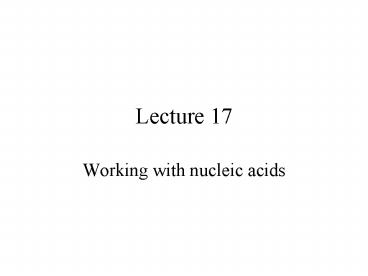Working with nucleic acids PowerPoint PPT Presentation
1 / 21
Title: Working with nucleic acids
1
Lecture 17
- Working with nucleic acids
2
The Genetic Code
3
Tools for understanding the genetic code/function
- Restriction endonucleases
- DNA polymerases/enzymes
- PCR
- Plasmids
- Site directed mutagenesis
- Northern and Southern blotting
- Yeast two-hybrid system
- DNA microarrays
4
Restriction endonucleases
5
Restriction enzymes
Cleavage site
Cleavage site
GGCC CCGG
GGATCC CCTAGG
BamHI
HaeIII
Cleavage site
Cleavage site
Produces blunt ends
Produces sticky ends
center of symmetry
6
Visualizing DNA fragments
Agarose gel electrophoresis
Load DNA
-
Apply electric field
Decreasing fragment size
Stain with EtBr
7
Plasmids
- Circular DNA (3 kB-15 kB)
- Readily taken up by E. coli (Transformation)
- Contains an antibiotic resistance cassette
- (for selection)
- Contain polylinker region for easy insertion
- of genes
- Gene coding for protein is inducible
Transformation will be discussed in lab next week.
8
How to clone a gene into a plasmid
9
Cloning into an expression vector
1. Find restriction enzyme sites at end of
gene 2. Isolate gene fragment 3. Cleave plasmid
with same restriction enzymes 4. Isolate plasmid
(without linker) 5. Ligate gene fragment and
plasmid 6.Transform into E. coli, select for
antibiotic resistance
10
PCR(Polymerase chain reaction)
Amplifies small amounts of DNA Taq (or pfu) DNA
polymerase allows multiple rounds without the
addition of more enzyme
11
Genomic Libraries
cDNA library
Genomic library
All mRNA from a cell
Chromosomal DNA
Reverse transcriptase
Cleave with restriction enzyme
DNA fragments
DNA fragments
Put into cloning vectors
Put into cloning vectors
12
Isolating a gene in a library
Replicate on nitrocellulose
probe
Treat with NaOH
ssDNA bound to nitrocellulose
Plate transformed with plasmid library
13
Northern blotting
Detects amount of a gene transcribed
(probe for specific sequence)
Radiolabeled oligonucleotide
mRNA with complementary sequence
Run agarose gel on cell extract. Many mRNAs ,
transfer to nitrocellulose
14
Southern blotting
(probe for specific sequence)
Radiolabeled oligonucleotide
DNA with complementary sequence
Run agarose gel on cell extract. Transfer to
nitrocellulose (Single stranded DNA)
15
E. coli
Most common organism used for genetic engineering
- Advantages
- Fast growing (doubling time 30 min.)
- Well-characterized transcription processes
- Plasmids (or phages) are easily incorporated
- Disadvantages
- Lacks capability of mRNA processing
- Lack posttranslation processing steps
- Introduced protein may be toxic to the cell
16
Protein overexpression
- Requires inducer
- Lac operon
P
O
Z
Y
A
I
Control sites
Code for protein
Regulatory gene
17
Protein overexpression
- In absence of inducer, regulatory protein binds
to operator and prevents synthesis of protein
P
O
X
I
Control sites
No protein produced
Repressor protein
- In presence of inducer, regulatory protein cannot
bind - to operator, protein is produced
P
O
X
I
IPTG
Control sites
Protein produced
Repressor protein
18
E.coli expression vector
19
Yeast two-hybrid system
20
DNA Microarrays
21
(No Transcript)

